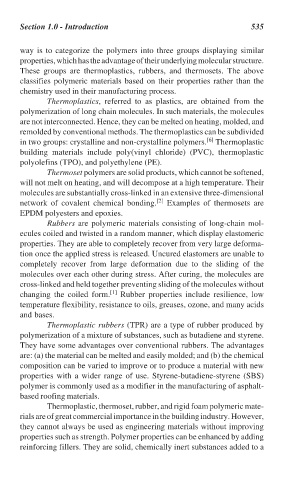Page 565 - Handbook of Thermal Analysis of Construction Materials
P. 565
Section 1.0 - Introduction 535
way is to categorize the polymers into three groups displaying similar
properties, which has the advantage of their underlying molecular structure.
These groups are thermoplastics, rubbers, and thermosets. The above
classifies polymeric materials based on their properties rather than the
chemistry used in their manufacturing process.
Thermoplastics, referred to as plastics, are obtained from the
polymerization of long chain molecules. In such materials, the molecules
are not interconnected. Hence, they can be melted on heating, molded, and
remolded by conventional methods. The thermoplastics can be subdivided
[6]
in two groups: crystalline and non-crystalline polymers. Thermoplastic
building materials include poly(vinyl chloride) (PVC), thermoplastic
polyolefins (TPO), and polyethylene (PE).
Thermoset polymers are solid products, which cannot be softened,
will not melt on heating, and will decompose at a high temperature. Their
molecules are substantially cross-linked in an extensive three-dimensional
[2]
network of covalent chemical bonding. Examples of thermosets are
EPDM polyesters and epoxies.
Rubbers are polymeric materials consisting of long-chain mol-
ecules coiled and twisted in a random manner, which display elastomeric
properties. They are able to completely recover from very large deforma-
tion once the applied stress is released. Uncured elastomers are unable to
completely recover from large deformation due to the sliding of the
molecules over each other during stress. After curing, the molecules are
cross-linked and held together preventing sliding of the molecules without
[1]
changing the coiled form. Rubber properties include resilience, low
temperature flexibility, resistance to oils, greases, ozone, and many acids
and bases.
Thermoplastic rubbers (TPR) are a type of rubber produced by
polymerization of a mixture of substances, such as butadiene and styrene.
They have some advantages over conventional rubbers. The advantages
are: (a) the material can be melted and easily molded; and (b) the chemical
composition can be varied to improve or to produce a material with new
properties with a wider range of use. Styrene-butadiene-styrene (SBS)
polymer is commonly used as a modifier in the manufacturing of asphalt-
based roofing materials.
Thermoplastic, thermoset, rubber, and rigid foam polymeric mate-
rials are of great commercial importance in the building industry. However,
they cannot always be used as engineering materials without improving
properties such as strength. Polymer properties can be enhanced by adding
reinforcing fillers. They are solid, chemically inert substances added to a

